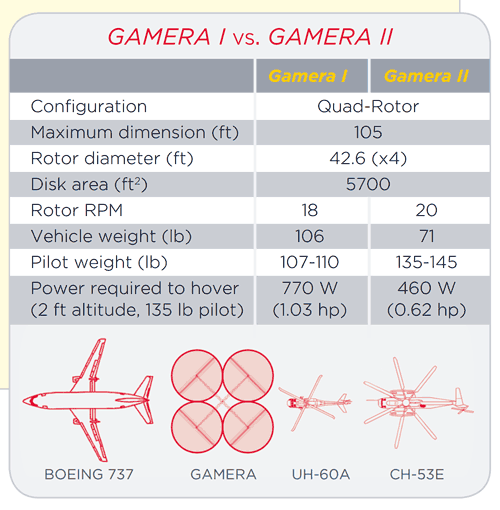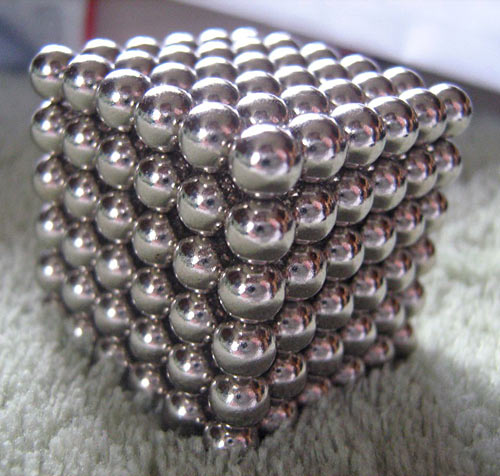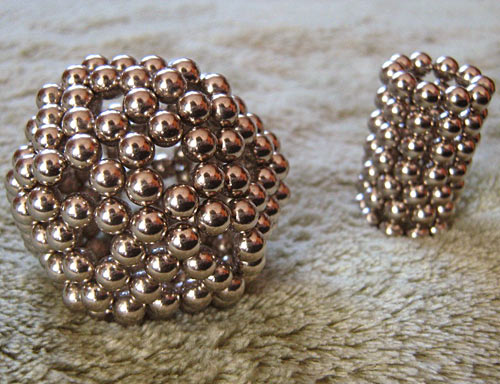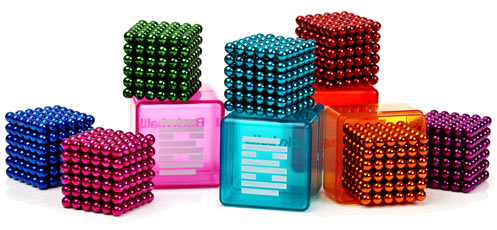The inimitable Matthias Wandel, having fun with the Venturi effect.
"Success will not deter us from further adventure."
7 September 2012 — dan"...And if we survive this first encounter, we might do that..."
"...with several carefully calibrated blows..."
Damn my impoverishing ethics! Damn them to hell!
6 September 2012 — danFrom: Stephen Sprogis <stephensprogis@hotmail.com>
Date: Wed, 5 Sep 2012 18:04:34 -0400
To: dan@dansdata.com
Subject: Extra money for youHi Dan,
I see you would like to recieve some extra money, so I'd like to offer you $10 a day to display an ad banner for Virtual Pilot 3d. I'd be happy to pay you the first 3 days upfront via Paypal, and every Monday thereafter as long as we're in business. Let me know if you're interested.
Sincerely,
Steve
I ditched Burst Media as my annoying-banner-ad provider on dansdata.com a while ago (they didn't close my account with no explanation, I QUIT, that's my story and I'm sticking to it). So just sticking a hard-coded banner at the top of every page and getting a no-muss-no-fuss seventy bucks a week for it doesn't seem like a bad idea at all.
(DealExtreme showed some interest in running a banner too, which would be a very natural fit for the site, but we had a lot of trouble communicating. Their banner-ad-buying person does not seem to be one of their English-understanding people. Perhaps when they complete their long voyage to the new and improved dx.com, which is now working fine in parallel with the old site, they'll have another go. If someone reading this is from DealExtreme, or anywhere else that is in honest business and would like to buy a simple whole-site ad on dansdata.com or this blog, talk to me!)
I'm not going to stick a static ad on my site if it's promoting a terrible piece of software, though. So I had a little look for reviews of this Virtual Pilot 3D thing, of which I'd never heard.
Those reviews seem oddly thin on the ground. Hit one in my Google search is a press release, hit two is virtualpilot3d.eu, and hit three is a page on virtualpilot3d.eu called, of all things, "Virtual Pilot 3D™ Scam", full of what seems to be machine-translated gibberish.
That weird European site also has a page called "Virtual Pilot 3D™ Is Not Flightgear", which explains:
...As previously noted, a division or segment of society Flightgear was a very special reason. The FG and the Virtual Pilot 3D™ There are major changes between.
Virtual Pilot 3D™ some outstanding features include:
* Enhanced plug and play system running smoothly.
* Very complex and require technical knowledge to start a game without having to perform a quick easy way.
...et cetera.
Presumably this was also machine-translated from something else, but I think I get the gist. Why are they so enthusiastic about telling us their flight simulator isn't some other flight simulator?
Back to looking for reviews. The fourth hit is people discussing Virtual Pilot 3D on a flight-sim forum, one of whom points to the Wikipedia article for the free open-source flight simulator... FlightGear.
It would appear that the Virtual Pilot 3D people have, at time of writing, been unsuccessful in getting that Wikipedia article to not point out that their commercial product is a rebadged version of FlightGear.
You can't take Wikipedia as gospel about everything, though, and it doesn't have any sources for the specific claim that Virtual Pilot 3D, as opposed to other commercial flight-sims called "Flight Pro Sim, Pro Flight Simulator, etc", is a FlightGear rebadge job.
So let's take another tack.
Rock, Paper, Shotgun covers pretty much everything worth knowing about PC gaming. When some oddball game comes up for $2.49 on Steam and I've no idea what it is, Rock, Paper, Shotgun almost always has a review.
They also have a regular column, The Flare Path, about military strategy games and flight-sims. I wonder...
Well, that was easy. The Flare Path for the 24th of August is, entertainingly, titled "Don't Buy VirtualPilot3D".
My name is Tim Stone. I've been a flight simmer for thirty years, and a flight sim critic for 4369 days, 9 hours, and 37 minutes. In all that time I don't think I've ever loathed a piece of software as passionately as I loathe the game you are currently thinking about buying. If you can spare a moment I'll explain why.
Oh, my.
The Virtual Pilot 3D people didn't just copy FlightGear; they also ripped off demo videos and images from completely different flight-sims, and photos from real life, presenting them all as being from Virtual Pilot 3D.
Picture allegedly of Virtual Pilot 3D.

Picture definitely on a NASA site.
And then, there's this...
...oh, just read it, it's funny.
This isn't the worst case of game "authors" ripping things off from other people and hoping no-one will notice. The worst case would be the point-and-click adventure game Limbo of the Lost, which also scored coverage on Rock, Paper, Shotgun, and even has its own wiki. (The wiki is largely devoted to tracing the illegally-copied sources for every component of Limbo of the Lost, including little-known indie oddities like Thief 3 and Oblivion.)
But gee, the Virtual Pilot 3D guys really are trying for the game-scam gold medal, aren't they?
Well, there goes my ten bucks a day. It's normal for annoying Web banner ads to sometimes be for scammy products, but deliberately running a constant ad for known scam-software exceeds the limits of even my highly elastic ethics. If the guy was offering me a thousand dollars a day, then since he's not actually selling fake antivirus software or botnet infectors or something (as far as we know...), I'd run the ad, take the money, kick half of it back to local charities and sleep the sleep of the just. But I doubt I'd be able to haggle him up that far.
So, until Sir Dolly Santos of the East Umbopoland Embassy To Nigeria comes through with that $US57,144,000 he promised me after I wired him $500, readers are still cordially invited to reward me for my honesty concerning Virtual Pilot 3D by making a small donation.
No, wait. Make it a large one.
On the Gratuitous Creation of Anachronistic Timekeeping Devices
5 September 2012 — danBehold, Marshall Damerell's water clock!
Or, if you'd prefer something a little more shed-ish...
...here are a couple of Tim Hunkin's shots at the idea.
(Tim's a little over-broad in the above video when he says that accurate timekeeping has only really been important since the advent of the railways. Accurate timekeeping for the great majority of people was, indeed, not terribly important until a surprisingly long time after the Industrial Revolution. But accurate timekeeping for ships has been important ever since humans first managed to make boats physically able to sail far from shore. You can tell what your latitude is without knowing the time, but without an accurate clock you can't estimate your longitude, unless there's a known island or coastline in sight.)
As regular readers know, Tim Hunkin was responsible for The Secret Life Of Machines, which you can, and should, legally download for free.
Boomting!
4 September 2012 — danThere are disadvantages to living on several acres out in the country.
It's a long walk to the shops. Fast Internet can be a problem. If you're having a heart attack, the ambulance may come too late.
But on the other hand, there's this.
(I'm sure I've linked to videos of anvil shooting on previous occasions; hell, the pastime's even had its own TV special now. But if anything deserves a repost...)
Some might suggest that standard anvil patterns have a hollow in the bottom because it saves a little weight and a little money, and has no effect on the all-important hammer-bounciness of the top surface.
Others know the real reason.
The Gossamer Whirlybird
3 September 2012 — danCheck this out:
It's the University of Maryland Gamera II (named for the flying-turtle kaiju) Human-Powered Helicopter. In the above video, Gamera II is achieving its altitude record, of two and a half metres.
Which isn't much, but is pretty impressive when it's only in the air because the pilot is managing, from pure muscle strength, to push enough air downwards to levitate himself and the contraption he's sitting in.
Gamera II looks like a total fake in that video, because they didn't get the whole enormous thing in shot, in this indoor testing area. (This helicopter is, of course, not likely to react well to outdoor breezes.)
Here's another test with a wide shot:
Now Gamera II barely looks as if it's getting off the ground at all. This is part of the secret of its success: Even when the helicopter's more than two metres off the ground, the four gigantic rotors are still in deep ground effect, making more lift than they would if they were even half of their 13-metre diameter off the ground.
Among Gamera II's numerous weight-saving cheats is the drive system for the rotors. You'd expect a shaft or belt, but instead there's just a cord wrapped around each rotor's drive wheel like the string around a yo-yo. The cord is wound in by the little wiry dude in the middle cranking away with both hands and feet. When the cord runs out, after only about sixty seconds, the flight is over.
Sixty seconds is enough to win the Sikorsky Prize for human-powered helicopters, though. To win fame and a quarter of a million dollars, your helicopter must have a flight duration of 60 seconds, and reach an altitude of three metres (9.8 feet), which Gamera II has now very nearly achieved.
Thanks to the yo-yo-string drive and various other ingenious tricks, the whole Gamera II weighs 71 pounds - a little more than 32 kilograms.
The little bubble-canopied Bell 47 helicopter...
...famous for its countless appearances on M*A*S*H, had a maximum takeoff weight of 2950 pounds (1340 kilograms).
With its sixty-kilogram little-wiry-dude pilot on board, Gamera II's takeoff weight is 203 pounds - about 92.2 kilograms. So, about 14.5 Gamera IIs to the Bell 47.
(The Bell 47 is also the only helicopter that actually makes that distinctive "chiew-chiew-chiew..." noise that's become the stock sound effect for any movie or TV helicopter being shut down.)
Gamera II, like numerous other human-powered or otherwise-required-to-run-from-not-many-horsepower aircraft, really is huge. The Sikorsky Prize requires the helicopter to remain in a ten-metre (32.8 ft) square during its flight, but I presume that only applies to the middle of the helicopter, since the whole of Gamera II does not even come close to fitting in a ten-metre square. From the outer edge of one rotor disk to the outer edge of the disk opposite it, Gamera II is 105 feet, 32 metres, in diameter.
The Gamera II info-handout PDF has this handy little table in it:
The helicopter's plan-view footprint is indeed similar to that of a 737, bigger than the US military's biggest helicopter, and way bigger than a Black Hawk.
Forget that, though. This thing's even bigger than the sadly unpopular Fairy Rotodyne:
(The Rotodyne was a compound gyroplane that drove its rotor for takeoff and landing, but cruised with the rotor spinning freely, like an autogyro. The rotor was also driven by tip-jets, not a shaft, so the Rotodyne didn't need a tail rotor. The deafening noise of the tip-jets on takeoff and landing is usually cited as a major factor in the commercial failure of the Rotodyne.)
(I just finished watching the two-part documentary Jet! When Britain Ruled the Skies; the Rotodyne scores a mention toward the end. My favourite part of Jet! was when the narrator, who has only played the Queen once, said "Not only did Capital Airlines fly the Viscount, but they also admired its virtues, in that warming, homespun way that only Americans can fake.")
The Rotodyne's rotor had a diameter of ninety feet - 27.4 metres. That's 15 feet (4.6 metres) smaller than the Gamera II's diagonal.
If you want really big helicopters, you need to go to the Soviets.
The Mi-24 "Hind" is still flying today...
...(probably because all the service manual says is "oil main rotor bearing every three years"). The Hind's rotor diameter is a mere 17.3 metres, though. Four-thirds as big as a single Gamera II rotor, but only 54% of the Gamera II's total maximum diameter.
OK, what about the Mil Mi-26 "Halo"?
Forty metres long, 11,400 horsepower... rotor diameter 32 metres.
The Gamera II would fit neatly on the Halo rotor footprint, sort of like the Vitruvian Man.
And how about the defunct Mil Mi-6 "Hook"?
Rotor diameter 35 metres. Conclusively bigger than the Gamera II.
And, finally, the staggering Mil V-12 "Homer"...
...of which only two prototypes were built. Two slightly overlapping rotors (out of sync with each other, of course), each of which was 35 metres (115 feet) across.
OK, that one wins.
(For comparison, the Boeing Chinook, with its less-bizarre tandem rotor design, only has 18-metre, 59-foot, rotors.)
These comparisons are of course ridiculous; it's like comparing a dandelion seed head with different sizes of musket ball. I only did it to have an excuse to post a bunch of giant-helicopter videos.
(Some Wikipedia-helicopter-data-table writer must have enjoyed filling in the names of the three "powerplants" the Gamera II's used, and its cruise speed of "0 kn; 0 km/h (0 mph)".)
A frequently-to-be-repeated offer
31 August 2012 — danAnybody who runs a blog with more than one post a year will receive unsolicited offers of "content". I get them all the time.
It's a distinct category of spam. They offer you a "free" blog-post worth of text, and often also a small amount of money, in return for you publishing said text, a few words in which link to some Web site the contributor specifies.
This one's a little more interesting than most.
From: Robert Lobitz <r.lobitz@kasacapitalmarketing.com>
To: rutterd@OPTUSNET.COM.AU
[This is not a good sign. That e-mail address is the one on my dansdata.com domain registration; it's not my actual Dan's Data contact address, dan@dansdata.com, that anybody who visited the actual site could find. Mail to domain-registration addresses is sort of like when a phone caller starts out by asking if he's speaking to Mr or Mrs surname-of-partner-to-whom-you-are-not-married.]
Date: Thu, 30 Aug 2012 12:49:25 -0700 (PDT)
Subject: dansdata.com ArticleHello,
I would like to start by saying that I was thrilled to find dansdata.com - it's not everyday I find a website of this caliber!
[Whenever someone cold-e-mails me saying something like this, I Google what they just said and, usually, find a few thousand copies of the same text, making clear that they not only actually do find a site "of this caliber" every day, but may find one approximately every minute. This time, though, there were only a couple of hits. So, good so far!]
I am interested in having one of my unique and interesting to read articles
[Yeah! Sell it, baby!]
published on dansdata.com. In return, all I ask for is that you let me include a link to my site HIDXenonHeadlights.com from within the article --- I would be willing to offer a one-time monetary contribution as well. Please let me know if this sounds like something you'd be interested in.
Cheers,
Robert
Public Relations
KASA Capital
909-444-5100
As I write this, the first hit in a Google search for this gentleman's alleged name is an article called "A Brave New Reality: Changing the Bird Cages of the World"
I cannot, in all honesty, say that that article is truly "interesting to read". It's more like "first-year university student trying to make it to the specified page count when he didn't do the reading, has a killer hangover, and has to turn in the paper in one hour".
The "Brave New Reality" article is also almost entirely free of any actual information. The world must change, and the world changes, and we should change the world, apparently. But it does at least seem to be pretty close to "unique", and not sprayed all over umpteen other blogs that also accepted the "one-time monetary contribution".
(To see if a given chunk of text is a "proper" article and not a sort of journalistic copypasta, take a distinctive string from the article - in this case, let's use the rather odd "Among my pursuits and businesses are the caring of birds as protected pets" - and search for that. [Spelling errors make these searches a lot easier.] Your typical spam-article, scam e-mail or bullshit Wikipedia reprint sold on eBay will have a zillion hits. As I write this, though, the "Brave New Reality" article is only published, as opposed to discussed, on two sites, culturechange.org and evolvingsustainability.com. The latter site is currently down, and may belong to the same guy as the first site anyway.)
The real purpose of "Brave New Reality" is, of course, not to actually inform or entertain. It's to link to a site and get it some Google-juice. In this case, that site is BirdCages.net. Hence the rather stretched metaphor.
Hit two for Robert Lobitz's name is "Child-proofing the Bedroom". Again, it's plainly been written by someone who doesn't have much writing skill, and it doesn't really say very much, but it is unique to the site it's on. And it gets its link in, too, this time to BunkBeds.net, which unsurprisingly looks very much like BirdCages.net.
Those two sites are both subtitled "A KASA Store". KASA Capital are strangely reticent about how many of these sites there are in their "diverse network of e-commerce entities", but I think it's safe to say there are a lot of them. They seem to be kosher online shops, too; no discount Viagra or fake watches.
I wanted to see just how many of these sites there are. It took me a moment to find something to search for that was distinctive to sites following the BirdCages.net/BunkBeds.net template, but I managed it by searching for a couple of strings of the hours their customer-service phone line is open.
Motorcycle fairings, medical scrubs, baby changing stations, martial arts supplies, silk flowers, caviar, boxing bags, radio-controlled planes, bike carriers, easels... if I'm counting right, there are 20 KASA sites found by the above search. If they've got more than one template, they could have a lot more than twenty sites.
I think it's safe to say that KASA are not experts on train horns, bar stools, poker chips, fish tanks and so on. I would, in fact, bet good money that they're just drop-shippers, who never even see the products they sell. Buy at wholesale, sell at retail, send goods straight from the wholesaler to the customer, spend the rest of your day on the golf course.
(The contact-hours search didn't find HIDXenonHeadlights.com, the site the article Robert was offering me would have to link to, because HIDXenonHeadlights.com has a different template. Searching for a string from that site's contact page found a few more KASA sites.)
So as far as KASA's actual retail business goes, they may not be the best place to buy any of the numerous things they sell, but I see no reason to suppose they'll take your money and run.
This still doesn't make it a good idea for blog-owners to take link-buyers like KASA up on their offers, though.
For a start, all you get, besides however much money they offer, is this worthless fluff-content that only exists to link to some site that frequently has nothing to do with the site on which the fluff appears.
More importantly, if Google notice you're engaging in link-buying schemes - or have been so deeply idiotic as to allow links to link-buyers' sites to appear on your site for free - they'll punish you by reducing your site's PageRank, as well as that of the link-buyers themselves. Serious offenders can be erased from Google altogether until they perform suitable penance.
So I'm sorry, Robert, but unless the "one-time monetary contribution" is in excess of a hundred thousand dollars, I'm afraid I'll have to turn down your offer.
And congratulations: You're in a pretty lousy business, but you could be worse!
On little shiny magnets, and the end of human freedom
28 August 2012 — danA commenter on this post pointed to this new ban, in the Australian State of Victoria, on bundles of little rare-earth magnets...
...sold as constuction toys.
A few years ago, when these branded collections of spherical (and now also cubic) magnets were first gaining popularity, one of the sellers of such things noticed I'd written this, this, and this (and possibly they also noticed this), or just that I'm pretty high in the results for a Google search for rare-earth magnets. They offered to send me some of their "jewellery magnets", from which you can make bracelets and rings and uncomfortable earrings and so on, for review.
I said it looked as if the more complex shapes would be fiendishly difficult to create without all the magnets clicking together into a blob all the time, and asked if this was a problem.
They didn't reply. Or send me a free infuriating blob of magnets.
(Years ago, Mark picked up my Amazing Magnets ball and squished it into a coagulated impossible lump. I left it that way. It took Alan, whose lot in life it is to protect the world from the entropic influence of people like me and Mark, ages to reconstruct it.)
That constitutes the entirety of my professional involvement in the little-toy-magnets world. Perhaps I was wrong; it's demonstrably possible to make all sorts of nifty things with them:
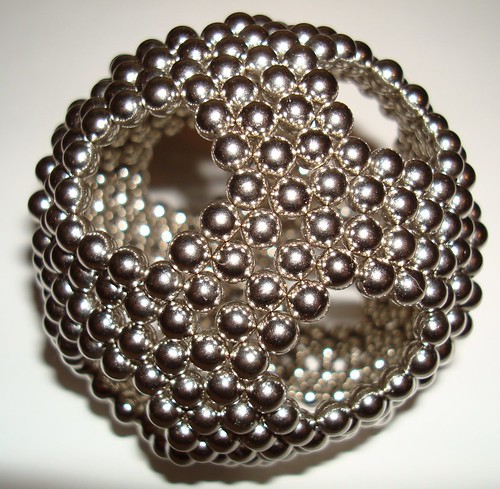
(Image source: Flickr user IslesPunkFan)
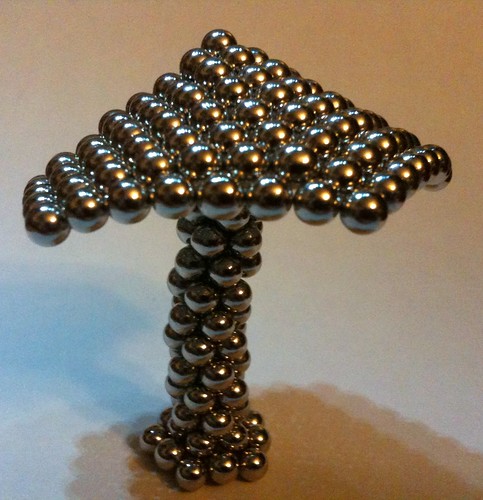
(Image source: Flickr user IslesPunkFan)

(Image source: Flickr user l0b0)

(Image source: Flickr user Happy Monkey)
Until now.
Toy magnets like these are now banned, in the process of being banned, or at least temporarily withdrawn from sale, in various jurisdictions both here in Australia and elsewhere.
All this excitement has happened because rare-earth magnets are dangerous to swallow.
They're not a poisoning hazard. An alternative name for the ceramic these magnets are made from is "NIB", for neodymium, iron and boron, and those elements are not particularly toxic to mammals individually or in combination. (Calling these things "neodymium magnets" is actually pushing it a bit; it's the neodymium in the formula that allows it to be magnetised so strongly, but the molecule is mostly iron, Nd2Fe14B.) The fragile black ceramic of the magnets themseves is almost always covered with a protective material, usually a plating of shiny nickel, but that's pretty harmless, too.
Swallowing one or more rare-earth magnets in one go is unlikely to do any harm at all. They'll just click together in your mouth or stomach, and probably pass through your gut without complications; even the block-shaped ones have rounded corners.
But if you swallow one or more magnets, then wait for them to move down your gut a bit, then swallow another magnet or three, the separate magnets or masses thereof can stick together with some of your tissue in between. This is likely to be Bad News.
(You can probably do something similar if you inhale one magnet after another, too. The above-linked medical literature also notes that a kid who's swallowed only one rare-earth magnet, and then goes in for magnetic resonance imaging, can find himself in a world of pain.)
These problems are not actually a new thing. As the New York Times points out, previous rare-earth-magnet construction toys have also been withdrawn, for the same reason.
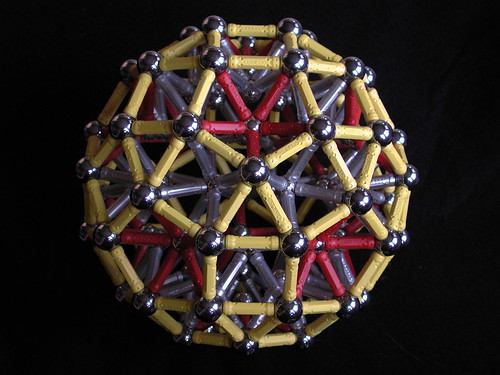
(Image source: Flickr user Karl Horton)
These toys first hit the big time with "Geomag"...

(Image source: Flickr user aldoaldoz)
...which is based around plastic pieces with small rare-earth magnets on their ends and corners. And Geomag wasn't an original idea, either; people had been making sculptures out of rare-earth magnets and steel balls for years (q.v. that Amazing Magnets ball, which I reviewed in 2002).
"Roger's Connection"...

(Image source: Flickr user IslesPunkFan)
...came out a couple of years before Geomag. It has much longer rods, and larger magnets recessed into the ends of the rods for a less wobbly connection. I bought a couple of sets years ago, and they're still on sale today, though perhaps not for much longer.
Geomag was the first really popular rare-earth-magnet construction toy, though, and it spawned umpteen cut-price competitors.
You can lever or chew the magnets out of the ends of Geomag-type components (or, for advanced experimenters...

(Image source: Flickr user Windell Oskay, one of the Evil Mad Scientists)
...dissolve the rods in acetone), and the magnets will just fall out of some of the really cheap and nasty Geomag knockoffs. And a child that eats one, waits a while and then eats another, may end up grievously injured.
"Magnetix" was the biggest Geomag knockoff brand and far from the worst-made, and it was withdrawn from sale in the USA after loose magnets killed one kid and put a few others in surgery.
Over the same period of time, bicycles killed, maimed and paralysed far, far more children, of course. But that doesn't make it OK to sell toys with small parts that fall off, even if those small parts don't have the ability to give you bowel ischemia via quantum physics.
The people who sell little round-or-square magnets under brands like...
...Buckyballs or Zen Magnets don't contest any of this. They've also previously cooperated with regulatory bodies by improving their safety warnings and complying with the usual bureaucratic labelling-law friction, like when Buckyballs said their toy magnets were suitable for children aged 13 and up, when existing local law said they only actually meet the requirements for 14 and up.
But now the magnet-sellers are being sued by the US Consumer Product Safety Commission, and have responded with...
...a "Save Our Balls!" campaign, and a petition, and so on.
Their argument is pretty straightforward: There are many things which, when left unattended, and found and eaten or otherwise interacted with by a toddler, can gravely harm said toddler. Few of these things are banned, because even if humans abandoned civilisation and returned to the trees, there would still be rocks and sharp sticks all over the place.
The CSPC's purpose is to "protect the public from unreasonable risks of injury or death". Their full complaint (PDF here) contends that these magnets do constitute such an unreasonable risk, because no warning on the box or in the instructions can prevent these little magnets from being left stuck to the fridge or on the floor or in some other place where small kids can find them. The CSPC also contends that older children, if they do things like simulating mouth and tongue piercings by putting a magnet on each side, can swallow or inhale the magnets and end up very ill. This has actually happened at least once. (Given the popularity of tongue studs and of these magnet toys, I bet older children have swallowed one or more magnets quite a lot of times. It's only likely to be a problem if they wait a while and do it again.)
I think the most important part of the CSPC complaint, though, and the part which raises it above mere Think Of The Children busybody nonsense, is that consumers demonstrably do not recognise the risk posed by toy-magnet products.
The CSPC are not complaining about knives, and saucepans full of boiling water, and automobiles, all of which harm and kill far more children per year than little magnets do, because it is generally recognised that children need to be protected from these things. Most people with toddlers, or even without, would not leave a straight razor taped to the fridge two feet off the ground.
But people haven't gotten a similar message about little magnets.
And it's not a theoretical problem; kids keep eating the damn things.
The CSPC complaint mentions only Buckyball- and Buckycube-branded magnets, but if it's upheld, I think you can can reasonably expect all such magnets to be banned in the USA.
I'm not certain, though. It could just end up banning such magnets when they're sold as novelties or toys.
This seems to be the way it's working out here in Australia. The Western Australian ban does not apply to "magnets used for industrial or scientific purposes"; similar exceptions are made in a 2010 Tasmanian interim ban (PDF here), and in the recent New South Wales interim ban (PDF here).
I'm actually quite heartened by the NSW ban, because it specifically says it only covers magnets "that are intended or marketed by the manufacturer primarily as a manipulative or construction desk toy or as jewellery".
This is still bad news for sellers of brightly-coloured marked-up magnet packs, and still means many ordinary consumers will miss out on being able to pay the premium to buy such items in ordinary consumer outlets, and probably won't be able to find them anywhere else.
But this ban says nothing about people selling un-marked-up magnets, without any statements about their purpose, for rather better prices on eBay and elsewhere.
Spherical magnets seem to be a little thin on the ground on eBay right now. Craft yourself a round-magnet-finding search string and all you'll see are disks and cylinders. I wouldn't be at all surprised if many sellers (overwhelmingly in China, which is where I think all cheap NIB magnets are made) decided to stop listing spherical magnets for a while, in case their products all get seized by Customs wherever they send them, and they then get lots of negative feedback.
If you cease to discriminate by shape, though, it's not hard to find inexpensive "Buckycube"-type cubic magnets.
"Buckycubes" are 4mm NIB cubes in a selection of colours. The cheapest no-name eBay cubes are all plated with silvery nickel, and may have thinner plating (or may not), but very small NIB magnets like these are generally hard-wearing; even the tiny contact points on spherical ones don't wear out that fast. And if they're way cheaper you probably won't care if the nickel flakes off a couple of them.
A 216-piece pack of Buckycubes will set you back $US39.95 + $US5.95 for shipping; 21.25 US cents per cube. To be fair, it'll probably cost you a bit less, since the Buckyballs people are for some reason currently having something of a fire sale, with coupon codes and such. 20% off your whole order seems to be easy to get; if that applies to shipping as well as the item price, then you'll be paying 18.4 cents per cube.
Restrict your eBay search to 4mm cubes, and as I write this you'll find the cheapest 216-piece pack for $US26.39 delivered; that's 12.2 cents per magnet. (Make sure you do a "world" search; local-currency prices in Australia, at least, are a bit higher. It seems that even China can't believe how crappy the US dollar is these days.)
This seems to be about the floor price. If you want a thousand-piece pack, it's $US119.99 delivered, a molecule less than 12 US cents per magnet.
UPDATE: I just noticed that well-known online cheapie-shop DealExtreme is shamelessly selling a set of 216 golden 3mm sphere magnets for $US15.40 delivered to anywhere, 216 5mm black spheres for $US17.10 delivered, and 125 4mm silver cubes for $US16 delivered. These are excellent prices to start with, and there are bulk discounts if you want to buy three or more units. Just don't try to re-sell them, if you live somewhere with these anti-toy-magnet laws!
UPDATE 2: More DealExtreme tiny-magnet sets. If you're a real penny-pincher they'll sell you a hundred minuscule 3-by-1mm discs for only $US4.10, and they have a nicely-packaged 216-3mm-sphere pack for $US15.60. 216 "silver white" 5mm spheres (which really do look silvery rather than just polished-steel-ish) are $US20.30, as are 216 golden 5mm spheres. 216 silver 4mm cubes will set you back $US18.70; 216 5mm cubes in the same finish are $US20.80.
Oh, and here are 216 red 5mm spheres for $US17 delivered!
(And then there's this kit, which only gives you 27 spheres and 36 long rods for $US15.90. But it comes in a nice little metal box! And here are yet more cubic ones in nice little tins. And here's a balls-and-bars set at DealExtreme that actually comes in Buckyballs packaging, which would normally mean it's a knockoff. Now, though, it may be the real thing, being sold where the product ban cannot reach.)
Again, these prices are all excellent, and you can get the usual bulk discounts; if you decided to buy a thousand of the super-cheap tiny discs, for instance, you'd pay $US33.90 delivered for the lot - three point four cents per magnet!
When I started writing this piece, I was all fired up to mention yet again that Kinder Surprise chocolate eggs with a toy inside are banned in the USA, and they're not banned in most other places, and the confectionery aisles of Australian supermarkets are not, so far as I have been able to determine, littered with the corpses of asphyxiated children, and presumably that's because all Australian shelf-stackers know how to administer the Heimlich maneuver. I also contemplated using the term "natural selection", with regard to children over the age of ten who eat their toys.
And as I've written before, I'm not crazy about preventing grown-ups from having things that could hurt children, or other adults, if used irresponsibly. Things keep being banned if they're possibly hazardous and, in the opinion of busybodies, more fun than they are useful. This is, to use the technical term, bullshit; it's the sort of Puritan worldview that bans recreational drugs for no reason other than that they are recreational drugs.
Most sane people accept, however, that it is difficult to make a case for private ownership of land mines in the civilised world.
Or, to pick a more realistic scenario, it is fair to prohibit the construction of booby traps on your own private land to catch trespassers, because even if it is your private land, you're living in a society here, and bear-trapping firemen, punji-staking tourists who wish to ask for directions, or SM-70-ing anyone who investigates the smell after you die in your house, has been decided by the rest of us to be unacceptable.
Less theatrically again, this is why the civilised world generally requires people building and maintaining structures to do so to something approaching local code standards, because you're not the only person who's going to have to deal with the place, even if nobody else busts in there until after you've died. If you want to have deathtrap electrical wiring, giant piles of fermenting garbage and guard dogs driven insane by mistreatment, get the hell out of the First World, because we've decided we won't put up with that. There's a limit to the risk to others that you're allowed to create in the name of individualism.
And so, after yet another reduction of the drama involved, we get to little shiny toy magnets.
On the one hand, they're fun, and the number of serious medical incidents they've caused is trivially small compared with those caused by skateboards, netball or hiking.
But on the other hand, they have been demonstrated to pose a real hazard, and there's no good way to mitigate it. No amount of "keep away from ALL children" warnings will make these small shiny lose-able objects actually inaccessible or unattractive to small children, and people don't seem to take the warnings seriously anyway. And even if you've no kids and no intention to have them, the little bastards are still likely to find their way into your house at some point.
And the danger isn't just of cuts and bruises. A perforated bowel will very probably kill you if you don't get serious medical treatment, whether you're four or forty.
One way to mitigate the danger of products and activities is to require licensing or other legal paperwork before someone can buy or do whatever it is. But this is for guns and cars and SCUBA and skydiving; it's ridiculous for executive-toy novelties.
We live in a world of imperfect solutions, and upon reflection, I think bans on small magnetic novelties aren't even the least perfect solution I've seen today. Especially if it's not a Ban On All Magnets.
As long as you can still buy 10,000 round NIB magnets with the same specs as the ones sold under special brand names on eBay, or wherever, or similarly buy tons of even cheaper disc magnets for the thousand and one things they turn out to be useful for, then I don't count destruction of the market for marked-up novelty-shop (or even worse) versions of the same things to be a great injustice.
I accept that the current magnet bans are much more likely to lead to truly onerous and irrational magnet bans than, say, the acceptance of gay marriage is to lead to people marrying farm animals. If and when someone tries to ban strong magnets in general, even huge ones that pose a serious danger to grown-ups, I will stand up and be counted in opposition.
But even as a quite serious appreciator of weird and wonderful toys and gizmoes, I see no strong grounds for complaint in bans on little magnets sold as toys.


